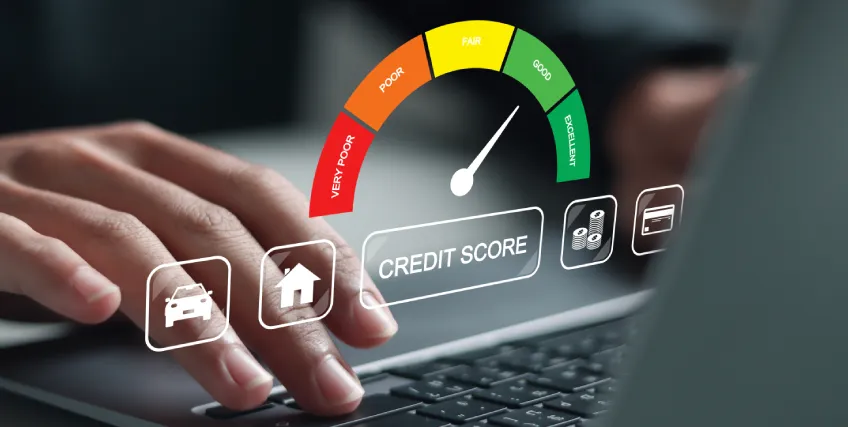Understanding Commercial Loan Rates: Terms, APR, and Costs Explained
July 08, 2025 | Last Updated on: July 08, 2025

If you’re a small business owner looking for funding to purchase, construct, or renovate real estate intended for commercial use, you will have to deal with commercial loan rates. Estimating the actual cost of borrowing can be more complex than it initially appears. It is not enough to understand just the interest rate and the loan term. The total amount you'll repay can be significantly impacted by variables other than the interest rate, such as the annual percentage rate (APR), loan terms, and hidden fees, which can further help you decide and compare your loan options.
This article will discuss key terms, the difference between interest rates and APR, how loan terms affect overall costs, and much more.
What Are Commercial Loan Rates?
Commercial loan rates refer to the interest charged by a lender on a loan extended to a business. Several factors determine commercial loan rates, including a combination of market and property-specific factors. Commercial loan rates are of two types:
- Fixed-rate: This type of commercial loan rates remains fixed throughout your loan term. This interest rate offers stability and protection against rising market rates. However, if market interest rates fall, fixed-rate borrowers won’t be able to benefit from those lower rates unless they refinance.
- Variable-rate: These commercial loan rates vary in response to changes in the underlying benchmark rate. Variable interest rates can fluctuate throughout the loan term. They can be beneficial when the market interest rate declines, reducing the overall cost. Moreover, they carry a risk of rising rates, which leads to higher interest rates and increases the overall cost of the loan.
Related Article: Commercial Loans
Types of loan options and commercial loan rates
- Term Loans: Term loans are a popular type of loan where a lender provides a lump sum of money to a borrower, who then repays it over a set period with regular installments. These loans are frequently used for commercial real estate purchases, remodeling projects, or refinancing existing debt.
- SBA loans: You can use an SBA loan to buy, construct, or improve commercial real estate. Several different SBA loans cater to various types of borrowers, with the most popular being the SBA 7(a) loan and the SBA 504 loan.
- Bridge Loans: You can use a bridge loan to provide short-term financing for commercial properties. They are typically used to bridge the gap between purchasing a property and securing long-term funding.
- Construction Loans: These loans are designed to finance the construction or renovation of commercial properties. These loans are short-term and are often used to purchase land, construct a building, or remodel an existing one.
Understanding Key Terms
It’s essential to understand the terminology used in commercial lending to secure better commercial loan rates.
- Loan Term: The period during which you’re required to repay a loan is known as the loan term. Depending on the lender and the type of loan, the loan term can vary significantly. It is essential to note that loan terms and interest rates are closely linked. Interest rates are generally higher for longer-term loans and lower for shorter-term loans.
- Amortization: Amortization is the process of distributing payments over a specified period of time. Although a more extended amortization period may result in lower monthly payments, it also means that interest will be paid on the loan for a longer period. As such, it's an important consideration.
- Balloon Payment: A balloon payment is a large, lump-sum payment due at the end of a loan term, followed by a series of smaller, regular payments. Balloon payments are considered beneficial because they give you the ability to repay your loan with lower weekly, fortnightly, or monthly repayments. It can make it easier to plan your monthly budget and manage your expenses.
- Loan-to-Value Ratio (LTV): A ratio of the loan amount to the appraised value of the asset securing the loan. A lower LTV means that a smaller portion of a property’s value is financed with a loan, and a larger share is covered by the borrower’s equity. This can mean less risk for the lender and leading to more favorable commercial loan rates.
- Debt Service Coverage Ratio (DSCR): The debt-service coverage ratio (DSCR) assesses a company's ability to use its cash flow to fulfill its existing liabilities. The DSCR helps investors and lenders determine whether a company generates sufficient income to meet its debt obligations.
How Lenders Calculate Commercial Loan Rates
Interest rates on commercial real estate loans are typically determined by multiplying the prime rate by the lender's margin. The borrower's credit history, the loan terms, and the lender's risk assessment can all impact this margin. You can learn more about how commercial loan rates are determined and how they affect your interest rates by considering the following factors:
- Creditworthiness: When applying for a commercial real estate loan, your personal and business credit scores are critical. Best low interest business loans are more likely to be offered to you if you have a strong credit history (low debt, on-time loan repayments) and a higher credit score.
- Down payment: By lowering the lender's risk, a larger down payment can help you get a lower interest rate.
- Market Demand: Market demand and supply have a direct impact on interest rates. High demand leads to higher rates, while lower demand can result in lower rates.
- Property Type: Different property types reflect varying levels of risk and income potential. For example, office spaces may have different commercial loan rates than industrial and multifamily properties. Lenders analyze each investment property based on factors such as its stability, potential for vacancy, and overall market demand.
- Location: The property's location can impact commercial loan rates. Properties in high-demand or economically thriving areas may have lower rates than those in less desirable locations.
Interest Rate vs. APR: What’s the Difference
The interest rate is the basic percentage you’re charged on the loan principal. The higher the interest rate, the more you will pay over the life of the loan. It doesn’t include additional costs. Whereas the APR stands out for Annual Percentage Rate, which is a more detailed measure that includes the interest rate plus lender fees and other charges, expressed as an annual rate. Thus, APR is the actual overall cost of the loan.
Common Commercial Loan Costs and Fees
In addition to the interest, many loans come with additional fees that impact your monthly payments and should be factored into the calculation of the APR.
- Origination Fee: A one-time charge that a lender applies to process a loan, typically ranging from 0.5% to 3% of the loan amount. The purpose of this fee is to cover the expenses associated with setting up a loan, such as paperwork and underwriting.
- Application Fee: A non-refundable charge some lenders require to review and process your loan request. It’s usually charged when you submit your application and before you know if your loan will be approved.
- Underwriting Fee: Underwriting is the process of assessing and managing risk in a financial transaction, such as a mortgage or a new investment. Underwriters need to be paid for evaluating the cost of your loan request, and this is where underwriting fees come in.
- Closing Costs: Closing costs occur when the property title is shifted from the seller to the buyer. It includes legal, appraisal, and filing fees.
- Prepayment Penalties: A prepayment penalty is a fee that some lenders charge if you pay off all or part of your mortgage early. Since you’re paying early, it might reduce the lender’s expected return, and the lender might charge you a prepayment penalty.
How to Use Interest Rate & Business Loan APR to your Advantage
When selecting the best commercial loan rate for your specific situation, it is crucial to understand the distinction between interest rates and the annual percentage rate (APR). The interest rate influences your monthly payments, but the annual percentage rate (APR) provides a more accurate representation of the total cost of the loan, including fees and other associated expenses.
Both the interest rate and the annual percentage rate (APR) should be considered when evaluating mortgage offers, as they highlight different aspects of the same circumstances. The interest rate is a key factor in planning your mortgage budget, as it helps determine your monthly payments. APR, on the other hand, can help give you information about the total cost of the loan, including fees that you might not have thought about when merely examining the interest rate. It’s vital if you compare multiple loan offers with different fee structures.
Whether you want low APR business loans or want to just budget your monthly payments, by thoughtfully examining both, you can make a more informed decision and find the mortgage that aligns most closely with your financial goals.
Final Thoughts
With a good understanding of interest rates and APR, as well as how loan terms affect overall costs, and what fees are commonly included in commercial lending, one can make an informed decision. While Interest rates and APR can help you budget your loan, the terminology discussed above enables you to recognize the impact of ratios like LTV (loan-to-value ratio) and debt service coverage ratio. Lenders evaluate their risk through these ratios, which often dictates whether the borrower will get favorable commercial loan rates and terms.
FAQs on Commercial loan rates
1. What are the various factors that influence commercial loan rates?
Various factors influence the commercial loan rate, including your creditworthiness, market demand, property type, and location.
2. What are the advantages of variable interest rates?
Variable interest rates for small business owners who intend to keep the property briefly or expect to refinance before interest rates increase. These interest rates help borrowers secure a lesser initial expense. For small businesses attempting to manage their cash flow during those critical early days, these initial savings can be a huge help.
3. What are the different types of commercial loan rates?
Commercial loan rates are of two types: fixed and variable. Fixed interest rates remain constant throughout the loan, whereas variable interest rates fluctuate, changing according to market indexes.
4. What is a balloon payment?
A Balloon payment is a large, lump-sum payment due at the end of a loan term. It is considered beneficial because it allows you to repay your loan with lower weekly, fortnightly, or monthly repayments. It makes it easier to plan your monthly budget and manage your expenses.
5. What is the loan-to-value (LTV) ratio, and why does it matter?
The Loan-to-value ratio compares the loan amount to the property's appraised value. A lower LTV means that a smaller portion of a property value is financed with a loan, and a larger share is covered by the borrower’s equity, indicating less risk for the lender and leading to more favorable rates.
Frequent searches leading to this page
Related Articles
Term Loans are made by Itria Ventures LLC or Cross River Bank, Member FDIC. This is not a deposit product. California residents: Itria Ventures LLC is licensed by the Department of Financial Protection and Innovation. Loans are made or arranged pursuant to California Financing Law License # 60DBO-35839




